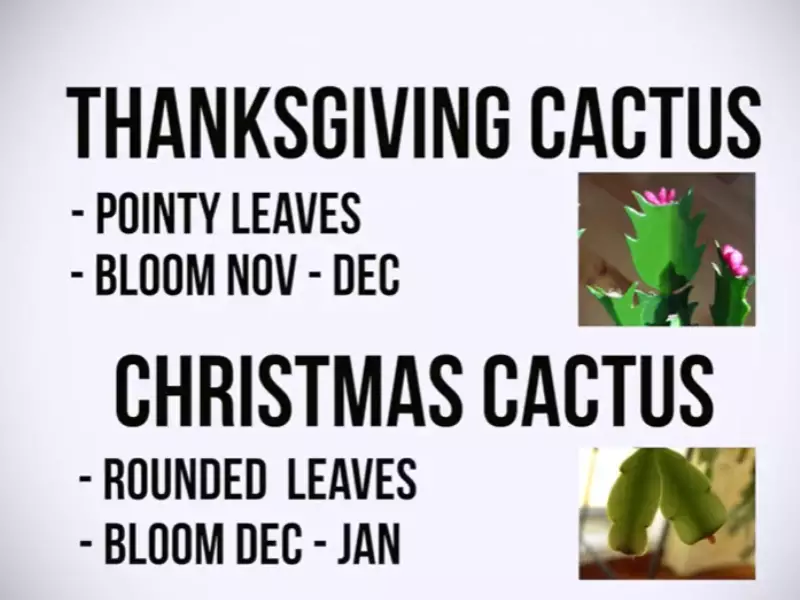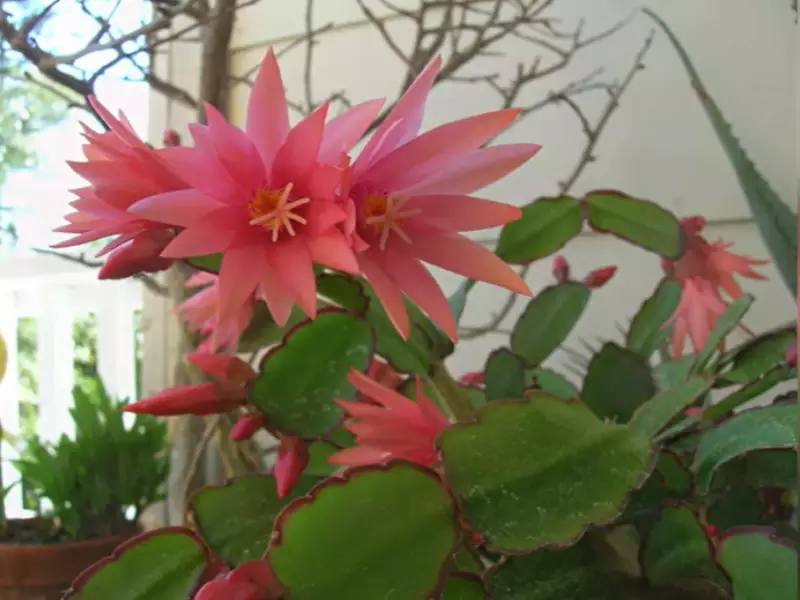Holiday cacti, specifically the Christmas cactus and the Thanksgiving cactus, have charmed gardeners and plant enthusiasts for generations with their vibrant blooms during the festive season. Despite their similar appearances and common confusion, these plants possess distinct characteristics that set them apart. Recognizing these differences enhances one’s ability to care for them properly and appreciate their unique beauty.
The Christmas cactus (Schlumbergera bridgesii) and the Thanksgiving cactus (Schlumbergera truncata) are primarily differentiated by their blooming period, leaf shape, and flower structure. The Thanksgiving cactus typically blooms from late fall into early winter, while the Christmas cactus flowers from late winter into early spring. Additionally, the leaf segments and flowers of each cactus have unique features that distinguish one from the other.
Both cacti are native to the Brazilian rainforest, where they grow as epiphytes in tree branches. This origin points to their preference for indirect light and high humidity, distinguishing them from desert-dwelling cacti species. Their adaptability to indoor environments has made them popular houseplants, especially during the holiday seasons when they’re often passed down through generations as cherished heirlooms.

Physical Differences
Leaf Shape
The leaf shape is a straightforward way to distinguish between a Christmas cactus and a Thanksgiving cactus. The Thanksgiving cactus has leaves with pointed and jagged edges that resemble crab claws, hence it’s sometimes called the crab cactus. On the other hand, the Christmas cactus sports rounded leaf edges, offering a softer appearance.
Comparison of Segment Shapes
- Thanksgiving Cactus: The segments are more rectangular in shape, with pronounced claw-like projections at the edges.
- Christmas Cactus: Features smooth, rounded edges on each segment, creating a more fluid and cascade-like appearance.
Bloom Time
Typical Flowering Periods
- Thanksgiving Cactus: Typically blooms from late October to late November, right around Thanksgiving in the United States.
- Christmas Cactus: Blooms a bit later, generally from late November through December, peaking around Christmas.
Flower Structure
Differences in Flower Appearance
The flower structures also present noticeable differences. The Thanksgiving cactus flowers are upright, with petals that open outwards, giving them a more star-shaped appearance. Christmas cactus flowers tend to dangle from the ends of the leaves and have a tiered or layered petal arrangement, creating a more delicate look.
Care Instructions
Watering Needs
Optimal Watering Strategies
- Allow the top inch of soil to dry before watering again.
- Reduce watering frequency during dormancy; slightly increase during blooming.
- Use lukewarm water to avoid shocking the plant.
Light Requirements
Ideal Lighting Conditions
- Indirect light is key; too much direct sunlight can cause leaf scorching.
- A north or east-facing window provides optimal light conditions.
- During the summer, consider providing filtered light or shade to protect the plant.
Temperature Preferences
Optimal Temperature Ranges
- Ideal daytime temperatures: 70-75°F (21-24°C).
- Nighttime temperatures should be cooler, around 60-68°F (15-20°C) to mimic their natural environment and encourage blooming.
Propagation Techniques
Cutting Methods
How to Properly Take Cuttings
- Choose a healthy, mature segment with at least 2-3 joined sections.
- Snip the cutting using a clean, sharp knife or scissors, just above a segment junction.
Rooting Process
Best Practices for Rooting Cuttings
- Let the cut end callous over for a few days to prevent rot.
- Plant the cutting in a moist, well-draining potting mix.
- Keep the soil consistently moist but not soggy and place the pot in indirect light.
Blooming Tips
Triggering Blooms
How to Encourage Flowering
- Shorter daylight hours: Mimic natural light conditions by ensuring the plant experiences longer nights (about 12-14 hours of darkness) for 6-8 weeks before the desired bloom time.
- Cool temperatures: Maintain cooler temperatures, around 50-55°F (10-13°C), during the night for the same period.
Maintaining Flowers
Tips to Prolong Bloom Life
- Avoid moving the plant once buds have formed; sudden changes can cause bud drop.
- Keep away from drafts and heat sources to maintain a stable environment.
- Humidity: Increase ambient humidity around the plant using a pebble tray or humidifier.

Common Mistakes
Caring for holiday cacti, like the Christmas and Thanksgiving varieties, involves more than just watering and placing them in a corner of your room. A few common mistakes can hinder their health and blooming potential. Understanding these pitfalls can greatly enhance your plant care routine.
Overwatering Consequences
Effects of Excessive Watering
Overwatering is a prevalent issue, leading to several problems:
- Root Rot: The most severe consequence of overwatering. If the soil remains soggy for too long, it deprives the roots of oxygen, causing them to decay.
- Leaf Drop: Excess water can stress the plant, leading to leaf segments falling off.
- Bud Drop: In bloom-sensitive plants like these cacti, too much water can cause budding flowers to fall before they open.
Prevention Tips:
- Check the top inch of soil for dryness before watering.
- Ensure pots have adequate drainage holes.
- During winter, reduce watering frequency as plant growth slows down.
Incorrect Lighting
Impact of Poor Lighting Conditions
Light plays a crucial role in the health and flowering of holiday cacti:
- Too Much Direct Sunlight: Can lead to leaf scorching, where leaves may turn yellow or red and become crispy.
- Insufficient Light: May prevent the plant from blooming and can cause leggy growth as the plant stretches towards the nearest light source.
Lighting Strategies:
- Place the plant in a location where it can receive bright, indirect sunlight.
- If direct sunlight is unavoidable, use a sheer curtain to diffuse the intensity.
- Consider using grow lights in darker rooms, ensuring they’re placed at an appropriate distance to mimic natural light without overheating the plant.
Holiday Traditions
Cultural Significance
Historical Context of Each Cactus
Both the Christmas and Thanksgiving cacti have been cherished for generations, not only for their festive blooms but also for their rich historical backgrounds:
- Thanksgiving Cactus (Schlumbergera truncata): Originating from the Brazilian rainforest, this plant was one of the earliest holiday cacti to be domesticated, admired for its early winter blooms that often coincide with Thanksgiving celebrations in the United States.
- Christmas Cactus (Schlumbergera bridgesii): This variant, also native to Brazil, typically blooms closer to Christmas. Its popularity soared as it became associated with the holiday season, symbolizing warmth, survival, and bloom during the darkest days of winter.
These plants often become heirlooms, passed down through generations, symbolizing continuity and connection to the past. They remind us of the cycles of life and nature’s ability to provide beauty even in less-than-ideal conditions.
Decorating Ideas
Creative Ways to Display
Incorporating holiday cacti into your holiday decor can add a unique and personal touch to your festivities. Here are some creative ideas to display them:
- Hanging Baskets: Allow the arching habit of the cacti to shine by placing them in hanging baskets. This not only showcases their beauty from all angles but also mimics their natural habitat.
- Centerpieces: Use blooming cacti as living centerpieces on your holiday table. Pair with candles or fairy lights for an added festive touch.
- Terrariums: For a modern twist, place smaller holiday cacti in terrariums with other humidity-loving plants. This creates a miniature tropical oasis.
- Holiday Wreaths: Incorporate cuttings from your holiday cacti into wreaths or garlands. Ensure they’re well-secured and mist them regularly to keep them fresh throughout the season.
Tip: Remember to keep your cacti away from cold drafts and heat sources, as sudden temperature changes can affect their health and bloom cycle.
FAQs
Can I make my Christmas cactus bloom at Christmas?
To encourage a Christmas cactus to bloom around Christmas, ensure it experiences about 12-14 hours of darkness at night and cooler temperatures around 50-55°F (10-13°C) starting in late September. This mimics their natural blooming triggers and helps set buds.
How do I distinguish between a Christmas and Thanksgiving cactus?
Identify the plant based on the shape of its leaves: Thanksgiving cactus has pointed and jagged edges, resembling crab claws, whereas Christmas cactus features rounded leaf edges. Additionally, the flowering time and flower structure can serve as clues, with Thanksgiving cacti blooming earlier.
Can these cacti be repotted?
Yes, both Christmas and Thanksgiving cacti can be repotted, preferably just after their blooming cycle. Choose a slightly larger pot with well-draining soil and ensure it has good humidity and indirect light to recover and grow healthily.
How often should I water my holiday cactus?
Water your holiday cactus when the top inch of soil feels dry to the touch. During active growth and blooming, they require more frequent watering, but always allow the soil to dry slightly between waterings to prevent root rot.
Conclusion
Understanding the differences between a Christmas cactus and a Thanksgiving cactus not only enriches our appreciation for these festive plants but also informs our care practices, allowing us to foster their growth and enjoy their beautiful blooms for many seasons. By recognizing their distinct characteristics, gardeners can ensure that these holiday cacti continue to be a vibrant part of family traditions and holiday decor.
Cherishing these cacti goes beyond their aesthetic appeal; it’s about preserving a piece of horticultural heritage and sharing it with future generations. As we tend to these plants, we nurture a connection to nature and a tradition that transcends the simple act of gardening, making the holiday season even more
